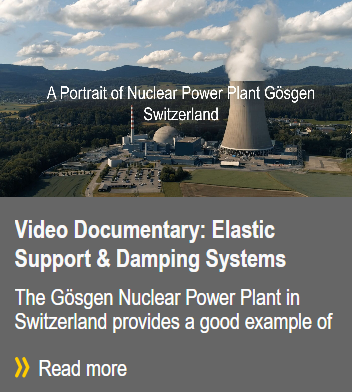info@gerb.com
Seismic Protection for SMR Structures
Enhancing Seismic Resilience of SMRs through Advanced 3D Isolation Systems with Tunable Stiffness and Damping
The global interest in Small Modular Reactors (SMRs) continues to grow due to their operational flexibility and ability to accommodate diverse site conditions. A critical factor for their safe deployment, however, is ensuring robust seismic resilience—particularly for standardized structural designs intended for multiple seismic environments. Advanced three-dimensional (3D) seismic isolation strategies, incorporating helical steel springs and viscous dampers, offer a promising solution to enhance structural performance during earthquakes. By independently adjusting stiffness and damping in all three spatial directions, these 3D systems allow precise tuning of structural responses, effectively reducing seismic accelerations and minimizing resonance amplification. The modular nature of the design further enables site-specific adaptations, such as modifying the number of dampers or spring elements, facilitating safe and efficient installation across a wide range of seismic zones.
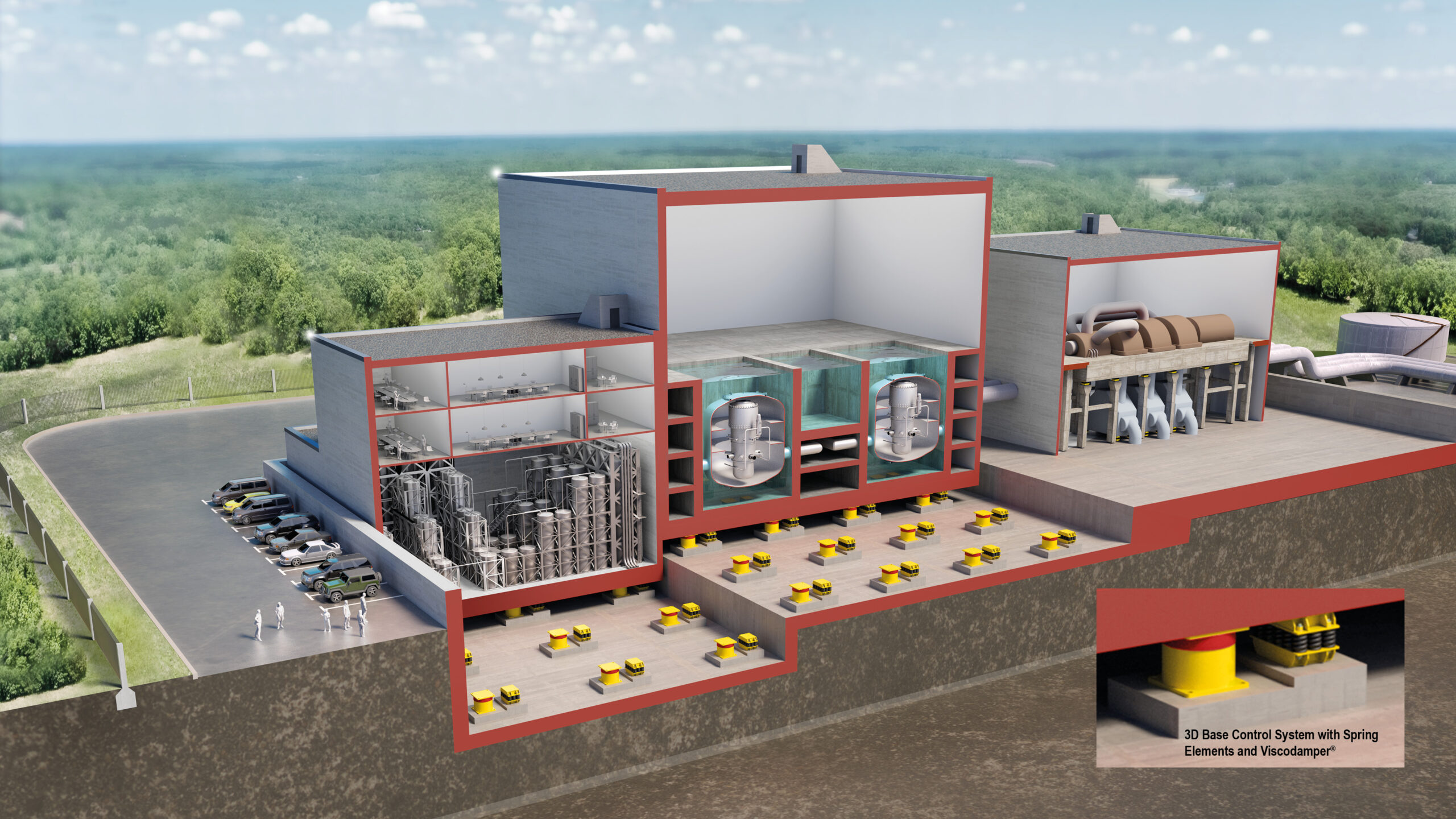
3D Base Control System
The Base Control System (BCS) consists of helical steel springs and highly efficient Viscodamper®, which are arranged underneath the structure. The system is flexible in horizontal directions, but possesses also a vertical elasticity. Viscodamper® supply absorption forces in horizontal and vertical directions. In particular the resulting demands (e.g. accelerations, base shear etc.) of the structure can be significantly reduced by using the BCS—due to reduction of frequencies and increase of structural damping.
By the way, of course the GERB 3D BCS does not only affect the forces acting on the structure itselve, but also the accelerations and forces of secondary structures, installations, and machinery inside the isolated structure are reduced. By introducing the proposed devices the acceleration values of the in-structural response spectra in horizontal and vertical directions can be significantly reduced in a wide frequency range.
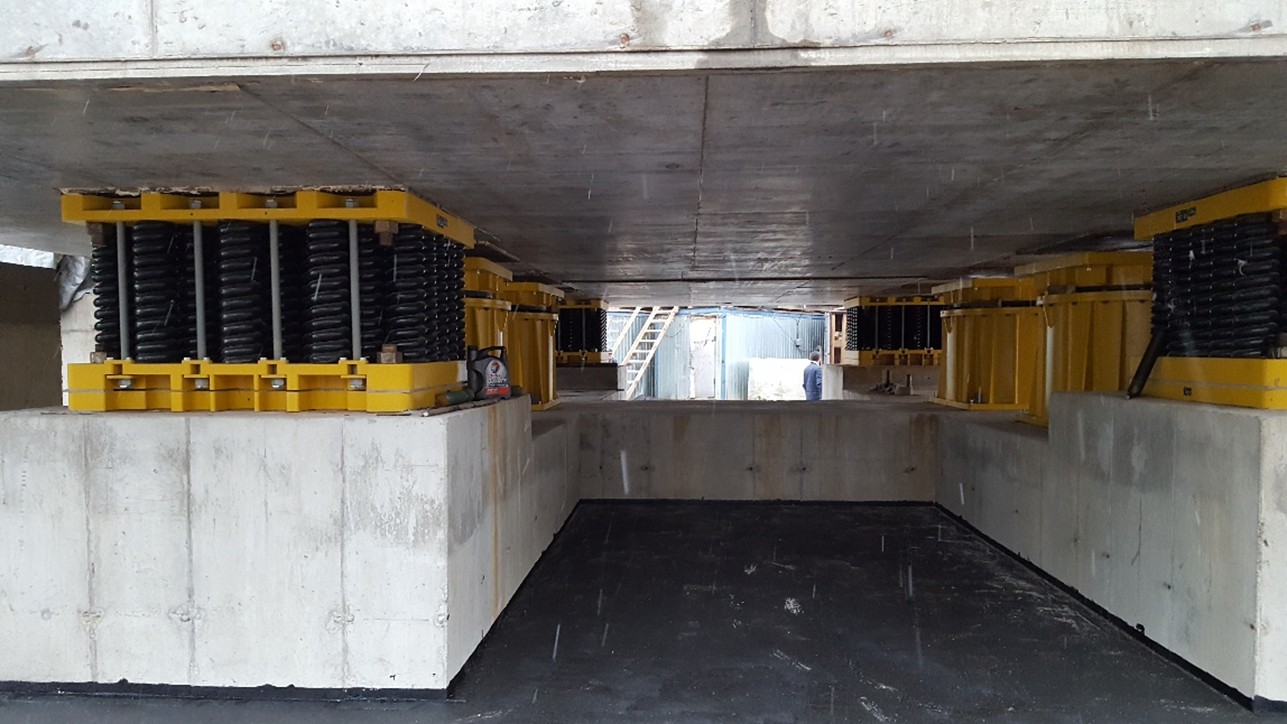
Modularity as a Key Factor in SMR Seismic Protection
Modularity is central to Small Modular Reactor (SMR) design—enabling standardized manufacturing, scalability, and flexible deployment. The same principle applies to seismic protection. GERB’s three-dimensional (3D) seismic isolation systems, using helical steel springs and viscous dampers, can be easily adapted to site-specific conditions. Simple modular adjustments, such as varying the number or configuration of spring and damper elements, allow precise tuning of stiffness and damping in all directions. This modular approach ensures efficient installation and optimized seismic performance across diverse locations as well as easy maintenance or expansion of the system.
Choice and development of a suitable spring and spring element system:

Choice and development of a suitable damper element:

References
Nawrotzki, P., Salcedo, V. and Siepe, D. (2013). “3-D Base Control Systems for the Seismic Protection of Power Plant Equipment and Buildings,” Proc., SMiRT-22, IASMIRT, San Francisco, CA, 1-8.
Nawrotzki, P., Wagner, H. G. and Siepe, D. (2017). “Vibration isolation and seismic protection of machinery and equipment in a NPP,” Proc., 1st International Conference on Nuclear Power Plants; Structures, Risk & Decommissioning (NUPP 2017), London, 208-215.
Nawrotzki, P., Siepe, D. and Enomoto, Y. (2024). “Optimized layout procedure for 3D seismic isolation systems for structures in NPPs,” Proc., SMiRT-27, IASMIRT, Yokohama, Japan, 1-9.
Siepe, D., Nawrotzki, P. and Bastet, J. (2023). “Damping Systems for Enhanced Safety of Nuclear Structures,” Proc., TINCE 2023 – Technological Innovation in Nuclear Civil Engineering, SFEN, Paris, 1-10.
Siepe, D., Nawrotzki, P. and Salcedo, V. (2025). “Modularity of 3D Seismic Isolation Systems,” Proc., SMiRT-28, IASMIRT, Toronto, Canada, 1-9.
Further Resources
You need further information on this topic?
Please do not hesitate to contact us with your individual question.
One of our project engineers will get back to you shortly.
Seismic Protection for SMR Structures
Enhancing Seismic Resilience of SMRs through Advanced 3D Isolation Systems with Tunable Stiffness and Damping
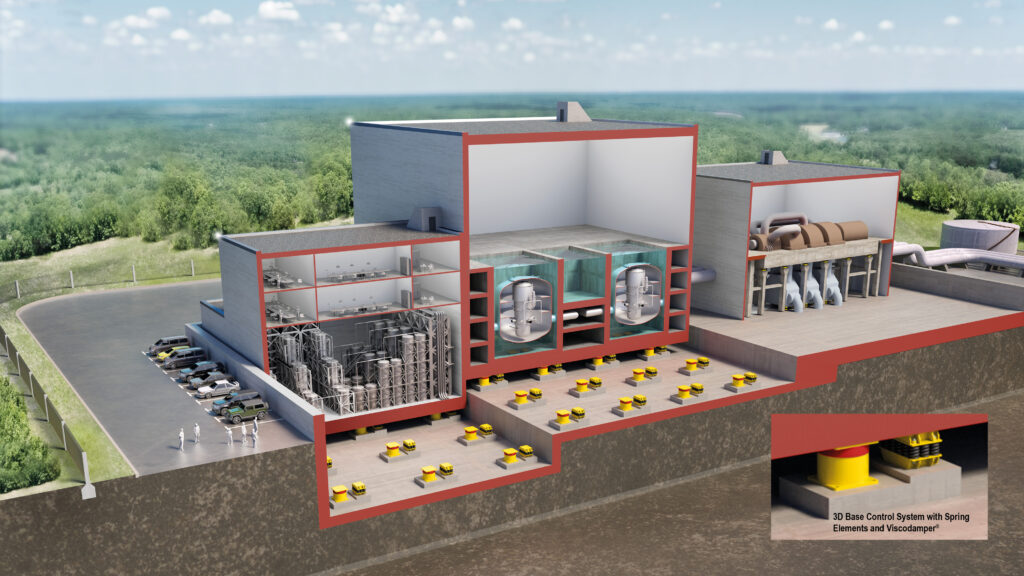
The global interest in Small Modular Reactors (SMRs) continues to grow due to their operational flexibility and ability to accommodate diverse site conditions. A critical factor for their safe deployment, however, is ensuring robust seismic resilience—particularly for standardized structural designs intended for multiple seismic environments. Advanced three-dimensional (3D) seismic isolation strategies, incorporating helical steel springs and viscous dampers, offer a promising solution to enhance structural performance during earthquakes. By independently adjusting stiffness and damping in all three spatial directions, these 3D systems allow precise tuning of structural responses, effectively reducing seismic accelerations and minimizing resonance amplification. The modular nature of the design further enables site-specific adaptations, such as modifying the number of dampers or spring elements, facilitating safe and efficient installation across a wide range of seismic zones.
Seismic Protection for SMR Structures
Enhancing Seismic Resilience of SMRs through Advanced 3D Isolation Systems with Tunable Stiffness and Damping
The global interest in Small Modular Reactors (SMRs) continues to grow due to their operational flexibility and ability to accommodate diverse site conditions. A critical factor for their safe deployment, however, is ensuring robust seismic resilience—particularly for standardized structural designs intended for multiple seismic environments. Advanced three-dimensional (3D) seismic isolation strategies, incorporating helical steel springs and viscous dampers, offer a promising solution to enhance structural performance during earthquakes. By independently adjusting stiffness and damping in all three spatial directions, these 3D systems allow precise tuning of structural responses, effectively reducing seismic accelerations and minimizing resonance amplification. The modular nature of the design further enables site-specific adaptations, such as modifying the number of dampers or spring elements, facilitating safe and efficient installation across a wide range of seismic zones.

3D Base Control System
The Base Control System (BCS) consists of helical steel springs and highly efficient Viscodamper®, which are arranged underneath the structure. The system is flexible in horizontal directions, but possesses also a vertical elasticity. Viscodamper® supply absorption forces in horizontal and vertical directions. In particular the resulting demands (e.g. accelerations, base shear etc.) of the structure can be significantly reduced by using the BCS—due to reduction of frequencies and increase of structural damping.
By the way, of course the GERB 3D BCS does not only affect the forces acting on the structure itselve, but also the accelerations and forces of secondary structures, installations, and machinery inside the isolated structure are reduced. By introducing the proposed devices the acceleration values of the in-structural response spectra in horizontal and vertical directions can be significantly reduced in a wide frequency range.
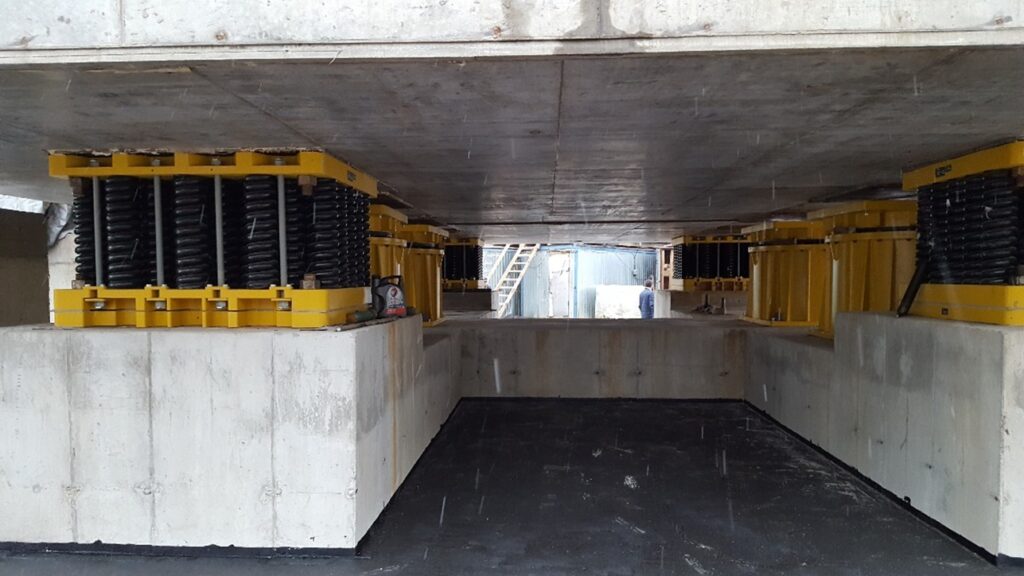
3D Base Control System
The Base Control System (BCS) consists of helical steel springs and highly efficient Viscodamper®, which are arranged underneath the structure. The system is flexible in horizontal directions, but possesses also a vertical elasticity. Viscodamper® supply absorption forces in horizontal and vertical directions. In particular the resulting demands (e.g. accelerations, base shear etc.) of the structure can be significantly reduced by using the BCS—due to reduction of frequencies and increase of structural damping.
By the way, of course the GERB 3D BCS does not only affect the forces acting on the structure itselve, but also the accelerations and forces of secondary structures, installations, and machinery inside the isolated structure are reduced. By introducing the proposed devices the acceleration values of the in-structural response spectra in horizontal and vertical directions can be significantly reduced in a wide frequency range.

Modularity as a Key Factor in SMR Seismic Protection
Modularity is central to Small Modular Reactor (SMR) design—enabling standardized manufacturing, scalability, and flexible deployment. The same principle applies to seismic protection. GERB’s three-dimensional (3D) seismic isolation systems, using helical steel springs and viscous dampers, can be easily adapted to site-specific conditions. Simple modular adjustments, such as varying the number or configuration of spring and damper elements, allow precise tuning of stiffness and damping in all directions. This modular approach ensures efficient installation and optimized seismic performance across diverse locations as well as easy maintenance or expansion of the system.
Choice and development of a suitable spring and spring element system:

Choice and development of a suitable damper element:

References
Nawrotzki, P., Salcedo, V. and Siepe, D. (2013). “3-D Base Control Systems for the Seismic Protection of Power Plant Equipment and Buildings,” Proc., SMiRT-22, IASMIRT, San Francisco, CA, 1-8.
Nawrotzki, P., Wagner, H. G. and Siepe, D. (2017). “Vibration isolation and seismic protection of machinery and equipment in a NPP,” Proc., 1st International Conference on Nuclear Power Plants; Structures, Risk & Decommissioning (NUPP 2017), London, 208-215.
Nawrotzki, P., Siepe, D. and Enomoto, Y. (2024). “Optimized layout procedure for 3D seismic isolation systems for structures in NPPs,” Proc., SMiRT-27, IASMIRT, Yokohama, Japan, 1-9.
Siepe, D., Nawrotzki, P. and Bastet, J. (2023). “Damping Systems for Enhanced Safety of Nuclear Structures,” Proc., TINCE 2023 – Technological Innovation in Nuclear Civil Engineering, SFEN, Paris, 1-10.
Siepe, D., Nawrotzki, P. and Salcedo, V. (2025). “Modularity of 3D Seismic Isolation Systems,” Proc., SMiRT-28, IASMIRT, Toronto, Canada, 1-9.
Modularity as a Key Factor in SMR Seismic Protection
Modularity is central to Small Modular Reactor (SMR) design—enabling standardized manufacturing, scalability, and flexible deployment. The same principle applies to seismic protection. GERB’s three-dimensional (3D) seismic isolation systems, using helical steel springs and viscous dampers, can be easily adapted to site-specific conditions. Simple modular adjustments, such as varying the number or configuration of spring and damper elements, allow precise tuning of stiffness and damping in all directions. This modular approach ensures efficient installation and optimized seismic performance across diverse locations as well as easy maintenance or expansion of the system.
Choice and development of a suitable spring and spring element system:

Choice and development of a suitable damper element:
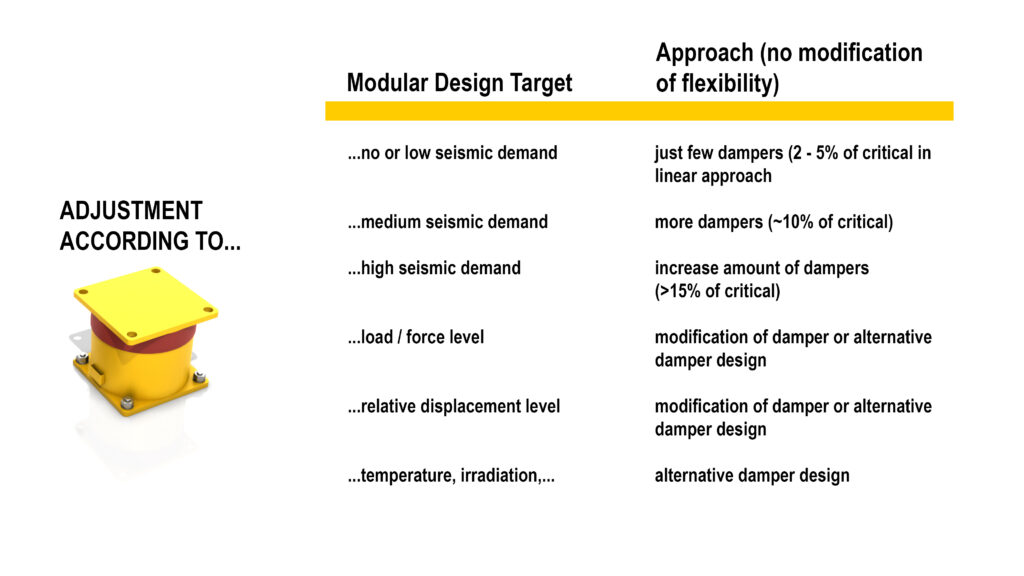
Modularity as a Key Factor in SMR Seismic Protection
Nawrotzki, P., Salcedo, V. and Siepe, D. (2013). “3-D Base Control Systems for the Seismic Protection of Power Plant Equipment and Buildings,” Proc., SMiRT-22, IASMIRT, San Francisco, CA, 1-8.
Nawrotzki, P., Wagner, H. G. and Siepe, D. (2017). “Vibration isolation and seismic protection of machinery and equipment in a NPP,” Proc., 1st International Conference on Nuclear Power Plants; Structures, Risk & Decommissioning (NUPP 2017), London, 208-215.
Nawrotzki, P., Siepe, D. and Enomoto, Y. (2024). “Optimized layout procedure for 3D seismic isolation systems for structures in NPPs,” Proc., SMiRT-27, IASMIRT, Yokohama, Japan, 1-9.
Siepe, D., Nawrotzki, P. and Bastet, J. (2023). “Damping Systems for Enhanced Safety of Nuclear Structures,” Proc., TINCE 2023 – Technological Innovation in Nuclear Civil Engineering, SFEN, Paris, 1-10.
Siepe, D., Nawrotzki, P. and Salcedo, V. (2025). “Modularity of 3D Seismic Isolation Systems,” Proc., SMiRT-28, IASMIRT, Toronto, Canada, 1-9.
Share this post
Further Resources
You need further information on this topic?
Please do not hesitate to contact us with your individual question.
One of our project engineers will get back to you shortly.
Further Resources
You need further information on this topic?
Please do not hesitate to contact us with your individual question.
One of our project engineers will get back to you shortly.
